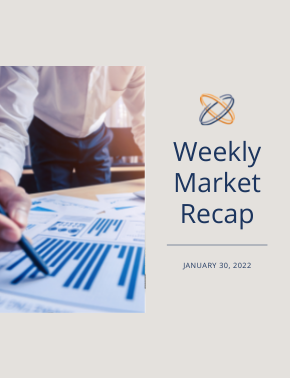Week in Review
Equity Markets:
It was a wild week in the markets. All three major indices broke their losing streak and ended the week positive. The S&P finished the week up 0.8%. At different points throughout the week, the S&P was in a correction, defined as down 10% from its recent high. The S&P finished the week down 7% on the back of a strong last hour rally Friday afternoon.
Volatility has been the theme so far this year, yet Monday’s volatility was quite abnormal. At the low of the day, the DJIA was down more than 3%. In the final hours of trading, it reversed course and ended the day positive. The point swing was eye opening, but it follows the trend for the year. Investors are still trying to get a grip on the current environment. The low-interest- rate, accommodative environment of the last ten years is a thing of the past. It will take time for the market to work through this, but like previous cycles, the market will work through it.
Earnings season is picking up. We saw reports from major companies like Apple, Microsoft, and Caterpillar. Numbers have been strong overall, although subdued from recent quarters. This is to be expected as we move later into the economic cycle. Of companies that have reported, rising cost pressures have been a theme for forward looking expectations. Wage costs and input costs have been a major topic from companies when looking at Q1 2022 earnings expectations.
Fixed Income Markets:
The 10-yr moved slightly higher this week, ending at 1.78%. The focus this week was the Fed meeting and suspected timeframe for increasing rates and reducing the balance sheet. Major takeaways were:
- Raising rates in March, which is in line with current estimates
- No longer providing liquidity to fixed income markets, i.e. balance sheet taper will be complete
- There will be a balance sheet reduction. This means the Fed will let currently owned assets mature and not reinvest. Or they may go as far as selling assets.
Economic:
GDP growth for 2021 was 5.7%, the fastest in over 30 years. The economic expansion has slowed according to some indicators like the IHS Markit’s composite gauge, but as we move past the early cycle, this is to be expected. The important thing is that growth is still happening. The IMF lowered its global economic growth for the year by 0.5%, citing concerns around inflation, the pandemic and supply disruptions globally.
Looking Ahead
Equity Markets:
The volatility theme will likely continue as we move closer to the Fed’s indicated timeframe for raising rates. For investors who can stomach the likely volatility over the next couple of months, it is important to remember that equities have historically performed well in the early stages of a tightening cycle. According to FactSet, over the last five tightening cycles, the average return over the year following the start of rate hikes has been 5%.
If historical trends continue, exposure to value and cyclical sectors are a place to benefit from a higher interest and inflation rate environment. These include Financials, Industrials, Energy and Materials.
Fixed Income Markets:
The 10-yr treasury has increased ~0.27% so far in 2022. This may not appear large on an absolute basis, but on a relative basis, rates have increased almost 18%. As we approach the 2% mark, which may be a big psychological barrier in investors’ minds, it is worth noting that an 18% increase from the current levels would have the 10-yr at ~2.09%. The volatility in the equity markets has been uncomfortable, but not out of the norm. We believe that rates settling into that 2% to 2.25% range for the year is a real possibility, so we should anticipate continued volatility in all markets.
We also believe it is important to keep in mind that what the Fed says and what the Fed does are two separate matters. Markets have priced in rate increases, but the Fed has yet to take action. If economic conditions appear to weaken, the Fed can swiftly change course with their new data-dependent stance on monetary policy decisions.
Economic:
Next week we will see regional manufacturing reports, followed by ISM’s Manufacturing and Services PMI. Friday’s nonfarm payroll report will be closely watched. The anticipation is for employment growth of 170,000 and a flat unemployment rate at 3.9%. These numbers are going to be major factors for the Fed’s actions going forward.
Important Disclosures:
Investment Advisory Services offered through Krilogy®, an SEC Registered Investment Advisor. Please review all prospectuses and Krilogy’s Form ADV 2A carefully prior to investing. This is neither an offer to sell nor a solicitation of an offer to buy the securities described herein. An offering is made only by a prospectus to individuals who meet minimum suitability requirements.
All expressions of opinion are subject to change. This information is distributed for educational purposes only, and it is not to be construed as an offer, solicitation, recommendation, or endorsement of any particular security, products, or services.
Diversification does not eliminate the risk of market loss. Investments involve risk and unless otherwise stated, are not guaranteed. Investors should understand the risks involved of owning investments, including interest rate risk, credit risk and market risk. Investment risks include loss of principal and fluctuating value. There is no guarantee an investing strategy will be successful. Past performance is not a guarantee of future results. Indices are not available for direct investment; therefore, their performance does not reflect the expenses associated with the management of an actual portfolio. The S&P data is provided by Standard & Poor’s Index Services Group.
Services and products offered through Krilogy® are not insured and may lose value. Be sure to first consult with a qualified financial advisor and/or tax professional before implementing any strategy discussed herein.














